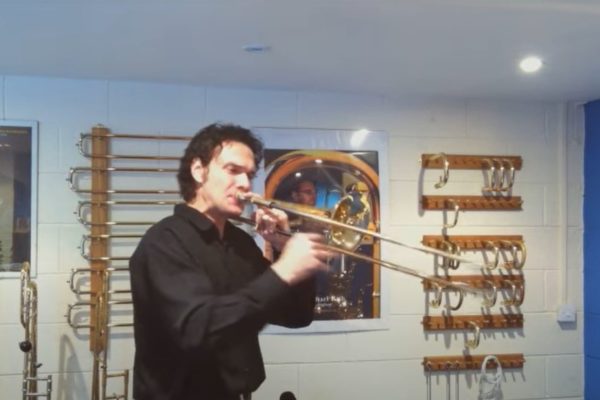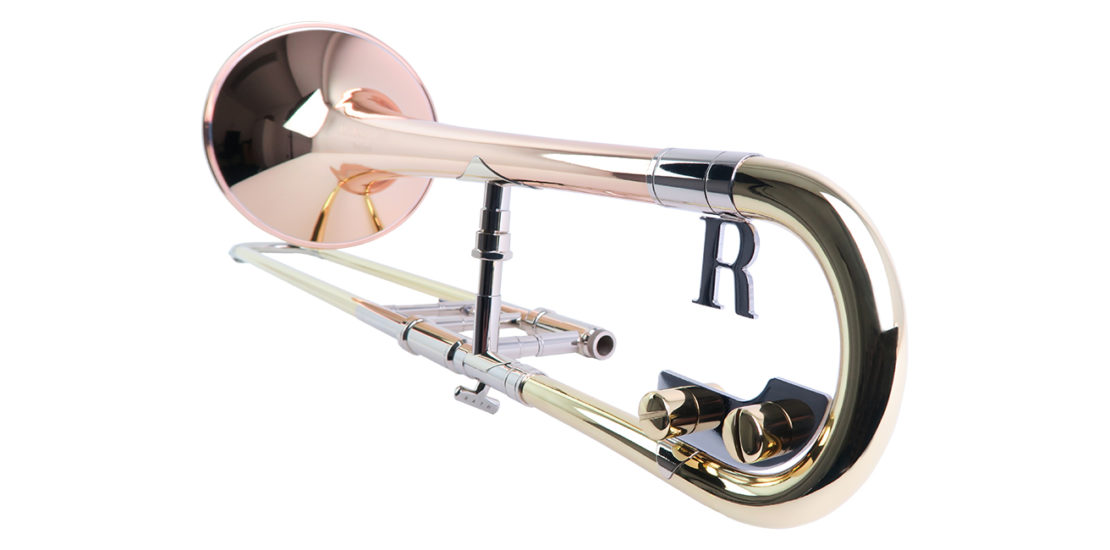
Alto TromboneR11 Alto Trombone - Features
Whether you’re looking for a clear, ringing alto sound for concerto performances, or a sound that’s more along the lines of a traditional German alto trombone or if you prefer a mixture of clarity with warmth to cover the widest spread of alto repertoire, then the R11 can be customised to cover all eventualities.
What is common for everyone, though, is the need for an alto that not only sounds like an alto rather than a tenor trombone but, equally importantly, is easy to play, is in tune with itself and does not require much adjustment by the player when switching from tenor trombone – in short playability. The R11 achieves these goals perfectly.
The R11’s slide has a comfortable seventh position for E and A and enough length to allow fine tuning of both of these. The slide tuning system means that the relative harmonics of the R11 are where you’d expect them to be and the relationship between harmonics does not change as you adjust the tuning which can be the case with many alto trombones with tuning in the bell section.
New lever design , more comfort and a quicker action.
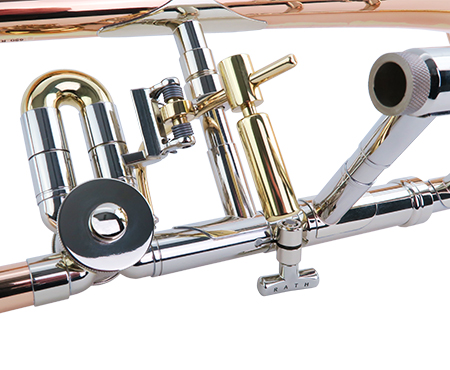
Like all Rath trombones, the R11’s slide action is superb and the small additional weight of the slide tuning system won’t slow you down, even on the most technical of passages.
There are two bore sizes for the R11 – the R11Z (0.481″/0.491″) and the R11K (0.481″/0.500″) and any of our usual options for bell, slide and bell crook materials and finishes can be specified. The standard bell flare size of the R11 is 6 3/4″, but a 7″ flare is available on request.
Two sets of interchagable leadpipes, the “Z” and “K” series, have been designed specifically for each bore size and can be ordered in brass, nickel, silver and also in bronze.
Valve Options
Rath alto trombones are also available with a standard rotor in Eb/D or Eb/Bb.
Or try our new design featuring a facility to convert from trill valve to Bb, just by changing the tuning slide.
“For more info or a quotation, please contact us”
Trill Valve

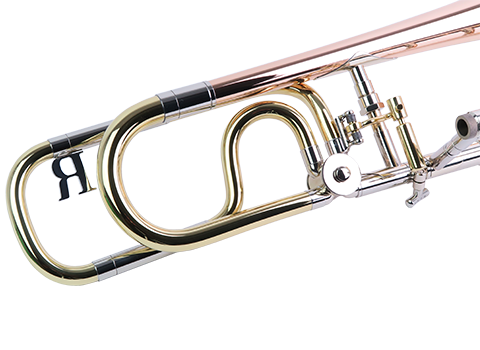
Detachable Bb tuning slide option.
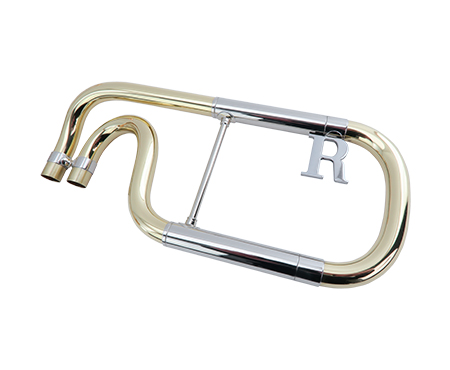
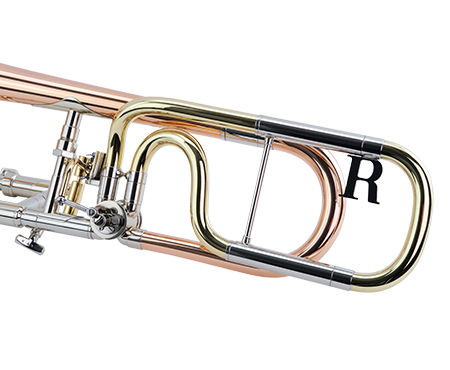
| Model | Bore | Bell Flare |
|---|---|---|
| R11Z | 0.481″ / 0.491″ | 6 3/4″ |
| R11K | 0.481″ / 0.500″ | 6 3/4″ |
How to order
If you’re in the UK, please contact us to arrange a testing session at our workshop and showroom.
0% interest free credit is available to UK customers, subject to terms and conditions. For full details, please contact us.
If you’re a student at a UK school then you may be eligible to order your Rath trombone without paying VAT on the Assisted Instrument Purchase Scheme.
If you’re outside the UK, please contact your nearest Rath dealer for further information, or alternatively, we’ll be happy to help you.

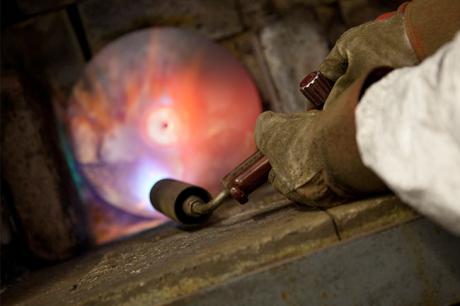
Michael Rath Custom Trombone bell flares offer wide range of tonal characteristics, each material giving a variety and flexibility of sound. They are available in yellow brass (70% copper, 30% zinc), gold brass (85% copper, 15% zinc), red brass (90% copper, 10% zinc) and nickel silver.
The higher the copper content in the material, the darker and warmer is the sound. For example a yellow brass bell will sound more brilliant and brighter than gold and red brass bells with a consistency of tone. Nickel silver bells tend to produce an extremely clear sound, but without becoming excessively bright. When coupled with the right main slide, tuning slide and leadpipe, nickel bells can also sound dark, full and resonant, particularly on our bass trombones.
For most players our standard bell size and weight will be the best choice – 7 1/2″ for medium bore tenor trombones (R1, R2, R10 and R12); 8″ for medium large bore trombones (R3); 8 1/2″ for large bore tenor trombones (R4) and 9 1/2″ for bass trombones (R9).

However a player may find that a different bell size better suits their needs hence other bell flares can be ordered. For example an 8″ bell flare on an R2 medium bore tenor trombone, or a 10″ bell flare for an R9 bass trombone. Bell flares can also be ordered not only in standard weight but also in light and heavy weights.
All Michael Rath bells are constructed in two pieces, a flare and a spout, allowing us to select the most appropriate gauge (or material thickness) for the bell flare and spout independently. They are produced entirely by hand in our workshop and are finished in clear lacquer as standard, although various other finishes are available.
Bell flares are stamped with the specification indicating the type and gauge of material used. For example, a bell stamped “750R” is made from red brass (R); with a flare gauge of 0.7mm and a spout gauge of 0.5mm.

Michael Rath slides are available in three different materials for the outer slide – yellow brass, bronze and nickel silver.
A nickel silver slide allows a more articulate, brighter sound than yellow brass or bronze and it can also feel more open on some component combinations. A bronze slide typically sounds darker and feels more centred. Bronze can be an excellent choice, for the R4 or R9 models, for a player searching for a dark, symphonic sound. Yellow brass slides sit in between nickel silver and bronze in terms of their tonal characteristics and feel.
Michael Rath slides feature dual radius nickel slide bows and an interchangeable leadpipe system. The connection, slide to bell section, has a locking system unique to our instruments.

The advantage of this system over a regular screw fitting is that the slide matches directly to the gooseneck, without any step in the bore.
In addition to the dual bore slide, standard on the R1, a dual bore slide is also available for the R3 (0.525″/0.547″) and R9 (0.562″/0.578″) models.
Michael Rath tuning slides are available in four different materials – yellow, gold and red brass, and nickel silver. They all have a dual radius design which is better suited to our trombones.
Yellow brass and nickel silver tuning slides allow for clearer articulations than gold or red brass and can feel slightly more open. Gold and red brass tuning slides, on the other hand, are generally a better compliment to yellow brass bell flares.
Bb tenor trombones have a balance weight fitted as standard, whilst the tuning slides of Bb/F tenor trombones and bass trombones are usually supplied without counterweights. However all tuning slides can be ordered with fixed balance weights.

Michael Rath weights are fitted with nuts with a screw thread allowing a player to adjust to a preferred balance. Alternatively a detachable weight system is also available.
Many existing players have found that adding weight improves the focus, centre and projection.

Choice of a leadpipe is an important factor in determining the sound, and particularly the response, of an instrument. Leadpipes are available for Michael Rath Custom trombones in three materials, brass, nickel silver and silver, and three sizes.
The standard leadpipe for each trombone model is in brass, whilst nickel silver gives a more brilliant sound and silver a darker, denser sound quality.
Extensive research has shown that, for most players, the standard taper leadpipe in brass is the best solution.
However in addition to our standard leadpipe, we also have leadpipe options based on the standard taper that are more focused , “A”, or more open ,”B”.
It is important to bear in mind that a leadpipe should also be a suitable match not only for your trombone but also for your mouthpiece.
For a large cup mouthpiece you may find that a leadpipe with a more open taper and feel is preferable. A shallow cup may be better with a tighter more focused leadpipe. And if you are changing your mouthpiece, a change of leadpipe may also be appropriate.
Below are the leadpipes currently available for our trombones. Each can be ordered in brass, nickel silver or silver.
| Rath R11Z | Rath R11K | ||
| Standard leadpipe for the R11Z | Standard leadpipe for the R11K | ||
| More focused than the standard Z leadpipe | More focused than the standard K leadpipe | ||
| More open than the standard Z leadpipe | More open than the standard K leadpipe | ||
| Rath R12 | Rath R10 | ||
| Standard Leadpipe for the R12 | Standard leadpipe for the R10 | ||
| More Focused than the Standard leadpipe | More focused than the standard 10 leadpipe | ||
| More open than the standard leadpipe | More open than the standard 10 leadpipe | ||
| Rath R1 | Rath R2 | ||
| Standard leadpipe for the R1 | Standard leadpipe for the R2 | ||
| More focused than the standard 1 leadpipe | More focused than the standard 2 leadpipe | ||
| More open than the standard 1 leadpipe | More open than the standard 2 leadpipe |
| Rath R3/R3F | Rath R8/R9 | ||
| Standard leadpipe for the R3. Small shank mouthpiece fitting. Also available in large shank fitting as 31L. | Standard leadpipe for the R8 and R9. | ||
| More focused than the standard 31 leadpipe. Small shank mouthpiece fitting. Also available in large shank fitting as 31AL. | More focused than the standard 9 leadpipe. | ||
| More open than the standard 31 leadpipe. Small shank mouthpiece fitting. Also available in large shank fitting as 31BL. | More open than the standard 9 leadpipe. | ||
| More open than the 9B. Particularly suitable for use with dual bore slides and /or large bass trombone mouthpieces. |
|||
| Rath R4/R4F | Rath R90 | ||
| Medium | Standard leadpipe for the R90 contrabass trombone. | ||
| Standard leadpipe for the R4 | More focused than the standard 90 leadpipe. | ||
| More open than the 41A. | More open than the standard 90 leadpipe. | ||
| Alternative to the 41A and 41B. Produces a more focused sound, but with open response. | |||
| More focused than the 5 leadpipe | |||
| More open than the 5 leadpipe |

There are two valve options available for Michael Rath Custom trombones, both Swiss designed: the René Hagmann valve and the Willson Rotax valve.
Both valves have their own distinct playing characteristics. The Hagmann is designed to cause as little disruption to the airflow as possible and feels very open in the valve register, even through the pedal register.
The Rotax valve is the best option if you prefer slightly more playing resistance, which can help with projection and focus.
However the Rotax valve is nowhere near as “stuffy” as a traditional rotary valve and the response on the valve is remarkably consistent when going from the open to the valve side of the trombone.

The majority of our Michael Rath instruments are supplied highly polished with a thin clear lacquer coating. We found that applying thicker coats of lacquer “deadens” the instrument, leading it being unresponsive and dull. However, despite only having a thin coat of lacquer, proper care and maintenance will keep the instrument always looking at its best.
Other finishes are available, such as brushed lacquer, coloured lacquer or without a lacquer coating at all. These can be applied to individual parts or to a complete instrument, giving you the opportunity to create an instrument uniquely yours.

R4F Hagmann , Black tinted , brushed Nickel bell.



